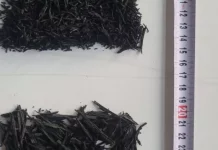
The ascender of China’s Chang’e-6 probe lifted off from the lunar surface on June 4, carrying samples collected from the moon’s far side.
The ascender—one of the four major components of the unmanned spacecraft—began its ascent at 7:38 a.m. Beijing Time and flew for about six minutes before reaching lunar orbit, according to the China National Space Administration (CNSA).
The return of the ascender into lunar orbit marked the successful completion of the first sampling and liftoff operation on the moon’s far side by any country, the space administration said.
The ascender carried out unmanned rendezvous and docking with the orbiter-returner combination in lunar orbit, and the samples were transferred to the returner.
The orbiter-returner combination will orbit the moon, awaiting the optimal time to re-enter Earth’s atmosphere, carrying the lunar samples and aiming to touch down at Siziwang Banner in Inner Mongolia Autonomous Region, the CNSA said.
The 8.35-metric-ton Chang’e-6 probe, the world’s first attempt to bring back samples from the far side of the moon, was launched on May 3 from the Wenchang Space Launch Center in Hainan Province and entered lunar orbit on May 8.
The lander-ascender combination separated from the orbiter-returner combination on May 30 and touched down at the designated landing area in the South Pole-Aitken (SPA) Basin on June 2.
Precise landing
According to Li Chunlai, the deputy chief designer of the Chang’e-6, the probe landed precisely at the designated area. This area is likely to be covered with a lot of basalt, which is very beneficial for geological research and can deliver significant scientific value.
The landing site is at an impact crater known as the Apollo Basin, located within the SPA Basin. The choice was made because of the Apollo Basin’s potential value for scientific exploration, as well as the conditions of the landing area, including communication and telemetry conditions and the flatness of the terrain, said Huang Hao, a space expert from the China Aerospace Science and Technology Corp. (CASC).
The colossal SPA Basin was formed by a celestial collision over 4 billion years ago and has a diameter of 2,500 km, equivalent to the distance from Beijing to Hainan, and a depth of about 13 km. It is the oldest and largest impact crater on the moon and in the solar system, and it may provide the earliest information available about the moon, according to scientists.
The huge impact of the celestial collision that formed the SPA Basin may have ejected materials from the depths of the moon. If such materials can be collected and returned to Earth for study, they would provide new insights into both the early impact history of the solar system and the geological evolution of the moon.
Huang added that the terrain on the far side of the moon is more rugged than the near side, with fewer continuous flat areas. However, the Apollo Basin is flatter than other areas on the far side, which made it conducive to landing.
The lander is equipped with multiple sensors, including microwave, laser and optical imaging sensors which can measure distance and speed, and identify obstacles on the lunar surface, Huang said.
To prevent interference to optical sensors by lunar dust during landing, the lander is also equipped with gamma-ray sensors to accurately measure the altitude through particle rays, ensuring that the engine shuts down on time and the lander touches down smoothly on the lunar surface, he added.
At the same time, the landing legs play a role as buffers, absorbing the impact energy of landing and ensuring the safety of the equipment on the lander.

Autonomous sampling
After the spacecraft finished its intelligent and rapid sampling work, the samples were stowed in a container inside the probe’s ascender as planned, the CNSA said.
It adopted two methods of moon sampling, including using a drill to collect subsurface samples and collecting samples on the surface with a robotic arm. It automatically gathered samples at different sites.
According to Jin Shengyi, the deputy designer of the lunar sample collecting and packaging system for the Chang’e-6 at the CASC, the Chang’e-6 probe development team built a simulation lab in advance to ensure a smooth sampling process.
Using this simulation, they developed and verified sampling strategies and equipment control procedures to ensure the accuracy of instructions.
Even with the help of the Queqiao-2 relay satellite service, the window for Earth-moon communication is still shorter on the far side of the moon than on the near side. Therefore, the sampling time of Chang’e-6 was reduced to about 14 hours, compared with the 22 hours used by its predecessor Chang’e-5.
To save time and improve efficiency, the development team made the sampling process more intelligent, allowing Chang’e-6 to execute instructions and make judgments autonomously to reduce the Earth-moon interactions, Jin said.
For example, instead of sending action-by-action commands, ground control was able to send a longer instruction. The probe then executed the multiple actions necessary to carry out that instruction and used the real-time data collected by the sensors to evaluate whether the instruction was well executed.
The multiple payloads installed on the lander, including the landing camera, panoramic camera, lunar soil structure detector and lunar mineral spectrum analyzer, worked well and carried out scientific exploration as planned, the CNSA said.
The lunar soil structure detector provided reference data for the sample drilling.
The three international payloads also successfully carried out their scientific detection objectives, according to the CNSA. The three international payloads are installed on the lander and consist of the lunar surface negative ion analyzer from the European Space Agency (ESA), France’s lunar radon detector and Italy’s laser retro-reflector.
The Chang’e-6 mission also carried a cube satellite from Pakistan that was aboard the orbiter. It separated from the orbiter on May 8 to carry out exploration activities, such as capturing images of the moon. China delivered data provided by the cube satellite to Pakistan on May 10.
After the sampling was completed, a Chinese national flag carried by the lander was unfurled for the first time on the far side of the moon. Due to the different landing positions, the national flag display system of the Chang’e-6 was improved on the basis of the Chang’e-5 mission.
Unlike takeoff on Earth, the ascender could not rely on a launch tower system, so the lander acted as the ascender’s launch pad.
The Chang’e-6 ascender’s takeoff from the far side of the moon differed from the Chang’e-5 ascent from the near side, as it could not directly receive ground control and support. It utilized its sensors to achieve autonomous positioning and orientation, with the assistance of Queqiao-2 for communication.

International cooperation
Ge Ping, spokesperson for the Chang’e-6 mission and Deputy Director of the CNSA’s Lunar Exploration and Space Engineering Center, believes that through detailed analysis of the soil structure, physical properties and material composition of the Chang’e-6 samples, scientists will be able to deepen research on the genesis and evolutionary history of the moon and the origin of the solar system, laying a foundation for later exploratory missions.
Chinese scientists will share scientific data generated by the mission with their international partners and carry out joint research, Ge said, noting that access to the Chang’e-6 samples will open for international applications at a later stage.
When watching the landing process at the National Astronomical Observatories, which fall under the Chinese Academy of Sciences, Pierre-Yves Meslin, principal investigator of France’s lunar radon detector program, said he and his colleagues had been thinking about this moment for years.
“We were looking at the moon almost every night here in Beijing,” he revealed, while adding that it is a very good idea to have international collaboration because scientific study requires a large community of scientists.
“It’s a very impressive and ambitious mission. We are very pleased to be a part of it. The collaboration has gone very smoothly,” said Neil Melville-Kenney, technical officer of the ESA’s Negative Ions on the Lunar Surface project.
“I think space exploration encourages us to consider our planet as one and our people as one,” he added.
China officially launched its Chang’e lunar exploration program in 2004. The program was named after the mythical Chinese goddess Chang’e who floated to the moon.
Luan Enjie, a senior adviser to China’s lunar probe program and former director of the CNSA, told China Science Daily that China’s lunar program consists of three stages, namely “orbiting,” “landing” and “returning” from the moon with lunar soil and rock samples.
“The first phase of the project involved developing and sending a lunar probe and making breakthroughs in key technologies of circumlunar exploration,” Luan said.
The second phase of the Chang’e program involved soft landing on the moon and patrol and survey of the lunar surface and the third phase involved collecting samples from the moon and returning the samples back to Earth for further research, according to Luan. –The Daily Mail-Beijing Review news exchange item





